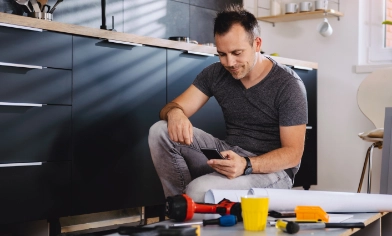What’s a home improvement loan?
There's really no such product as a home improvement loan. In fact, it's a regular unsecured loan – you just choose to use the cash to develop or do up your property. You can also get secured loans for home improvement, but they come with more risk should you default on your monthly repayments.
What can I use a home improvement loan for?
It’s up to you. Home improvement can mean anything from replacing a few tired items to gutting and reinvigorating your kitchen or bathroom.
You might need to do emergency work on your home to make it safe (but remember that some things might come under home insurance payouts), you might need more living space or working space and want to build an extension, and you could want to add value to your home. A personal loan for home improvements.
So working out the cost of the improvements you want to make upfront will help you plan how much you need to borrow.
Things to ask yourself include:
-
Are you going to do the work yourself or use contractors?
-
Can you source the materials you need or do you need a tradesperson to do this?
-
Have you researched the most competitive prices for items you want to buy (such as white goods)?
-
Are you able to make the monthly repayments, both now and in future?
-
Remember that if your property is listed then a large number of the kind of improvements that would be normal for another house will have to obtain approval - even things like changing the colour of an external wall.
Planning the work you want to do in detail means that you can create a budget that covers everything you need.
Making the most of funds for home improvement
Using contractors
The building trade doesn’t always have a good reputation, and this isn’t always fair. Ask those you know in your area who have had work done whether they’d recommend their builders and use that as a starting point. This is particularly beneficial if the house is of a similar age and size, and the work is of a similar nature. Friends and family might have good recommendations, but they’re only worth it if they’re in your area.
Don’t go with your first quote. It’s worth getting quotes from a number of builders first to check that those you’re being given are similar across the board. You can go with your preferred builders once you’re sure they’re giving you a fair estimate.
If you’ve got plans (for instance from planning permission submissions) then give these to the builders to help generate their quote. Giving them lots of detail, like your preferred materials and styles, can help them give an accurate estimate of cost.
Get your quotes in writing, and be certain that they include everything required: materials, scaffolding, cleaning up and so on. Be very hesitant if builders offer discounts for cash payments or offer to do the work VAT-free.
Try to get a feel for how thorough they’re being when they’re surveying your property. If they don’t seem particularly interested then they may not be inclined to do the most thorough job. And, as part of the quote, try to make sure that they agree to your timeline for the improvements.
Finally, once you’ve chosen your builder, make sure that there is a contract for the work rather than an informal or verbal agreement. This should include an agreed schedule of payments and everything that the builders are responsible for. You might also want to consider adding a ‘snagging period’ where you retain a small amount of the contract’s payment for a while after the work’s complete to make sure that any minor ‘snags’ can be ironed out.
Doing your own home improvements
Before undertaking your own home improvements, remember that doing things properly is crucial. You should always:
-
Conduct a PAT test on electrics every year (which is particularly important if you’re a landlord)
-
Conduct a full electrical survey every 5 years
-
Ensure you know what work needs to be approved by the local authority
-
Obtain necessary planning permissions for work
-
Remember that there are some electrical jobs that you need to get an electrician to do
Needless to say, only do significant work on things like plumbing when you are certain you know what you’re doing.
Remember that once you’ve decided to do home improvements yourself, that doesn’t mean you have to do it all if you don’t know how. For specialist jobs, for instance cornicing or stone masonry, you can follow the advice above on finding an expert.
When purchasing materials, remember that you will not get trade prices if you are not using registered tradespeople.
Why take out a loan for home improvement?
Emergency work
If you’ve had a home emergency and need to do repair work then the chances are that you’ll have already discussed the matter with your home insurance provider. Once you’ve established that you need to cover the cost of emergency work yourself then a personal loan for home improvements can help you avoid spending savings. If you are replacing and refitting something that was already a feature of the house, such as doing emergency plumbing work and taking up flooring, then the chances are that you won’t need planning permission. But remember that it’s always important to check, and some work might need local authority approval. There is a difference between seeking and obtaining planning permission, and making sure changes you make conform to building regulations. Your local authority are your best port of call to decide what permission you need to seek before undertaking work.
Extending living space
If you’re building an extension to your home then there’s a high probability you’ll need to obtain planning permission. If it’s possible that the work you’re planning will impact your neighbours’ views, visibility and the character of your area, then this is what planning permission was designed to protect.
But when you’ve got someone new on the way, or you need a home office or studio, or you simply want to extend your kitchen to be more spacious, make sure you understanding what the costs of the permission process will be when you factor this into your budget.
Increasing the value of your home
Remember that housing markets can change based on broad economic trends, and improving your home is not a guarantee that its overall value will improve. You can ask estate agents for their opinion on what certain improvements will do to the value of your home – many will provide free consultation or valuations.
If you’ve got an idea of how much your improvements could increase your home’s value by, you can compare this against the estimated cost of the work.
Much of this will depend on the state of your home as it currently is. If, for example, you’re a first-time buyer and have bought an old and run-down property, then improvements may have a big impact on your home’s value (as well as making the property more livable for you).
What are other options?
Secured loan
You can take out a secured loan for larger amounts. This is where the loan is guaranteed against the value of your house. Interest rates for secured loans tend to be lower than those for unsecured loans, however they come with greater risks.
And they also still have APR, which – considering you are likely to be borrowing a larger amount over a longer period of time – still means that you will ultimately need to pay back significantly more than the initial value of the loan. Failing to repay secured loans can carry more risk than unsecured loans so it’s important to only consider this option if you are sure you understand the implications.
Paying for home improvements on your credit card
It’s possible to put home improvements on your credit card, however it’s a less simple process. This is because your credit limit may be to too low to borrow the full amount necessary at one time. But if you can pay for the improvements, or part of them (for instance, materials) on your credit card then you may be able to take advantage of 0% APR introductory offers. As with all loans and credit, you’ll need to be sure that you can make repayments within the agreed timeframe.



